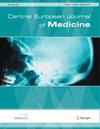Serum levels of sFas and sFasL in subjects with type 2 diabetes — the impact of arterial hypertension
引用次数: 1
Abstract
AimTo evaluate the serum levels of sFas and sFasL in normotensive subjects with different degree of impairment of glucose tolerance as well as in type 2 diabetic patients with treated and treatment-naïve hypertension (AHT).Material and methods124 subjects (63 males and 61 females), of mean age 46,31±10,78 years are included in the study, divided in 5 age-matched groups: 19 subjects with type 2 diabetes (DM) and drug-controlled AHT; 30 subjects with type 2 DM and drug-naïve AHT; 30 normotensive subjects with type 2 DM; 26 normotensive subjects with prediabetes and 19 healthy controls. Serum sFas and sFasL levels are determined by highly sensitive enzyme immunoassay technique.ResultsNo significant differences in sFas are observed among the studied groups. The levels of sFasL are decreased in normotensive subjects with type 2 DM (p<0,05), while subjects with prediabetes have intermediate values. In both hypertensive groups with DM sFasL levels are further decreased.ConclusionsSerum sFas levels probably are not associated with the presence of impairment of glucose tolerance or AHT. Serum sFasL values tend to be decreased in subjects with impairment in glucose tolerance; further decrease is observed in hypertensive subjects with type 2 DM. Antihypertensive treatment does not influence the levels of sFasL.2型糖尿病患者血清sFas和sFasL水平-动脉高血压的影响
目的探讨不同程度糖耐量损害的正常血压受试者以及2型糖尿病合并treatment-naïve高血压(AHT)患者血清中sFas和sFasL水平的变化。材料与方法纳入124例受试者(男性63例,女性61例),平均年龄46、31±10、78岁,分为5个年龄匹配组:2型糖尿病(DM)伴药物控制AHT患者19例;2型糖尿病合并drug-naïve AHT患者30例;血压正常的2型糖尿病患者30例;26名血压正常的糖尿病前期患者和19名健康对照者。血清sFas和sFasL水平采用高灵敏度酶免疫分析法测定。结果两组间sfa无明显差异。2型糖尿病患者的sFasL水平降低(p< 0.05),而糖尿病前期患者的sFasL水平处于中间水平。在两组糖尿病高血压患者中,sFasL水平均进一步降低。结论血清sFas水平可能与糖耐量或AHT损伤无关。葡萄糖耐量受损的受试者血清sFasL值有降低的趋势;2型糖尿病高血压患者的sFasL水平进一步下降。降压治疗不影响sFasL水平。
本文章由计算机程序翻译,如有差异,请以英文原文为准。
求助全文
约1分钟内获得全文
求助全文

 求助内容:
求助内容: 应助结果提醒方式:
应助结果提醒方式:


